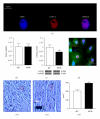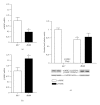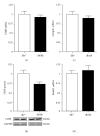Downregulation in GATA4 and Downstream Structural and Contractile Genes in the db/db Mouse Heart
- PMID: 22474596
- PMCID: PMC3313578
- DOI: 10.5402/2012/736860
Downregulation in GATA4 and Downstream Structural and Contractile Genes in the db/db Mouse Heart
Abstract
Reduced expression of GATA4, a transcriptional factor for structural and cardioprotective genes, has been proposed as a factor contributing to the development of cardiomyopathy. We investigated whether the reduction of cardiac GATA4 expression reported in diabetes alters the expression of downstream genes, namely, atrial natriuretic peptide (ANP), B-type natriuretic, peptide (BNP), and α- and β-myosin heavy chain (MHC). db/db mice, a model of type 2 diabetes, with lean littermates serving as controls, were studied. db/db mice exhibited obesity, hyperglycemia, and reduced protein expression of cardiac GLUT4 and IRAP (insulin-regulated aminopeptidase), the structural protein cosecreted with GLUT4. Hearts from db/db mice had reduced protein expression of GATA4 (~35%) with accompanying reductions in mRNA expression of ANP (~40%), BNP (~85%), and α-MHC mRNA (~50%) whereas expression of β-MHC mRNA was increased by ~60%. Low GATA4 was not explained by an increased ligase or atrogin1 expression. CHIP protein content was modestly downregulated (27%) in db/db mice whereas mRNA and protein expression of the CHIP cochaperone HSP70 was significantly decreased in db/db hearts. Our results indicate that low GATA4 in db/db mouse heart is accompanied by reduced expression of GATA4-regulated cardioprotective and structural genes, which may explain the development of cardiomyopathy in diabetes.
Figures








Similar articles
-
Expression of cardiac GATA4 and downstream genes after exercise training in the db/db mouse.Pathophysiology. 2012 Jun;19(3):193-203. doi: 10.1016/j.pathophys.2012.06.001. Epub 2012 Jul 17. Pathophysiology. 2012. PMID: 22809789
-
The effects of exercise training and caloric restriction on the cardiac oxytocin natriuretic peptide system in the diabetic mouse.Diabetes Metab Syndr Obes. 2017 Jan 11;10:27-36. doi: 10.2147/DMSO.S115453. eCollection 2017. Diabetes Metab Syndr Obes. 2017. PMID: 28138261 Free PMC article.
-
Decreased expression of natriuretic peptides associated with lipid accumulation in cardiac ventricle of obese mice.Endocrinology. 2010 Nov;151(11):5218-25. doi: 10.1210/en.2010-0355. Epub 2010 Sep 15. Endocrinology. 2010. PMID: 20844006
-
Molecular biology and biochemistry of natriuretic peptide family.Clin Exp Pharmacol Physiol. 1995 Jan;22(1):49-53. doi: 10.1111/j.1440-1681.1995.tb01918.x. Clin Exp Pharmacol Physiol. 1995. PMID: 7768034 Review.
-
Atrial and brain natriuretic peptides: Hormones secreted from the heart.Peptides. 2019 Jan;111:18-25. doi: 10.1016/j.peptides.2018.05.012. Epub 2018 May 31. Peptides. 2019. PMID: 29859763 Review.
Cited by
-
Exercise Reduces Glucose Intolerance, Cardiac Inflammation and Adipose Tissue Dysfunction in Psammomys obesus Exposed to Short Photoperiod and High Energy Diet.Int J Mol Sci. 2024 Jul 15;25(14):7756. doi: 10.3390/ijms25147756. Int J Mol Sci. 2024. PMID: 39062999 Free PMC article.
-
Heart failure with preserved ejection fraction in humans and mice: embracing clinical complexity in mouse models.Eur Heart J. 2021 Nov 14;42(43):4420-4430. doi: 10.1093/eurheartj/ehab389. Eur Heart J. 2021. PMID: 34414416 Free PMC article. Review.
-
Oxytocin and cardioprotection in diabetes and obesity.BMC Endocr Disord. 2016 Jun 7;16(1):34. doi: 10.1186/s12902-016-0110-1. BMC Endocr Disord. 2016. PMID: 27268060 Free PMC article. Review.
-
Functional thyrotropin receptor expression in the ventricle and the effects on ventricular BNP secretion.Endocrine. 2014 Jun;46(2):328-39. doi: 10.1007/s12020-013-0052-6. Epub 2013 Sep 26. Endocrine. 2014. PMID: 24065308
-
Ultrasonographic Characterization of the db/db Mouse: An Animal Model of Metabolic Abnormalities.J Diabetes Res. 2018 Mar 8;2018:4561309. doi: 10.1155/2018/4561309. eCollection 2018. J Diabetes Res. 2018. PMID: 29707583 Free PMC article.
References
-
- Kannel WB, McGee DL. Diabetes and cardiovascular risk factors: the Framingham study. Circulation. 1979;59(1):8–13. - PubMed
-
- Dries DL, Sweitzer NK, Drazner MH, Stevenson LW, Gersh BJ. Prognostic impact of diabetes mellitus in patients with heart failure according to the etiology of left ventricular systolic dysfunction. Journal of the American College of Cardiology. 2001;38(2):421–428. - PubMed
-
- Fisher BM, Gillen G, Lindop GBM, Dargie HJ, Frier BM. Cardiac function and coronary arteriography in asymptomatic type 1 (insulin-dependent) diabetic patients: evidence for a specific diabetic heart disease. Diabetologia. 1986;29(10):706–712. - PubMed
-
- Abbott RD, Donahue RP, Kannel WB, Wilson PWF. The impact of diabetes on survival following myocardial infarction in men vs women. The Framingham Study. Journal of the American Medical Association. 1988;260(23):3456–3460. - PubMed
-
- Depre C, Young ME, Ying J, et al. Streptozotocin-induced changes in cardiac gene expression in the absence of severe contractile dysfunction. Journal of Molecular and Cellular Cardiology. 2000;32(6):985–996. - PubMed
LinkOut - more resources
Full Text Sources
Other Literature Sources
Research Materials
Miscellaneous

